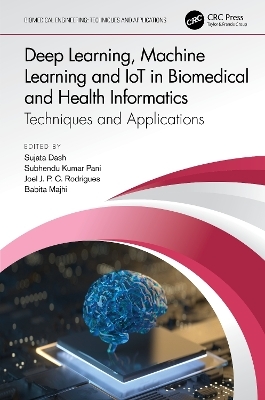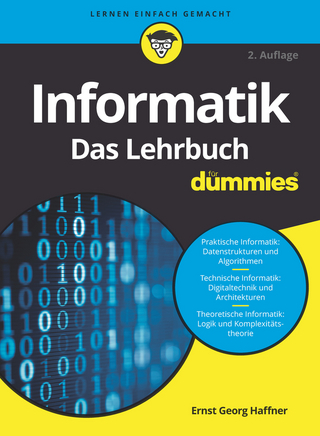
Deep Learning, Machine Learning and IoT in Biomedical and Health Informatics
CRC Press (Verlag)
978-0-367-54846-9 (ISBN)
Biomedical and Health Informatics is an important field that brings tremendous opportunities and helps address challenges due to an abundance of available biomedical data. This book examines and demonstrates state-of-the-art approaches for IoT and Machine Learning based biomedical and health related applications. This book aims to provide computational methods for accumulating, updating and changing knowledge in intelligent systems and particularly learning mechanisms that help us to induce knowledge from the data. It is helpful in cases where direct algorithmic solutions are unavailable, there is lack of formal models, or the knowledge about the application domain is inadequately defined. In the future IoT has the impending capability to change the way we work and live. These computing methods also play a significant role in design and optimization in diverse engineering disciplines. With the influence and the development of the IoT concept, the need for AI (artificial intelligence) techniques has become more significant than ever. The aim of these techniques is to accept imprecision, uncertainties and approximations to get a rapid solution. However, recent advancements in representation of intelligent IoTsystems generate a more intelligent and robust system providing a human interpretable, low-cost, and approximate solution. Intelligent IoT systems have demonstrated great performance to a variety of areas including big data analytics, time series, biomedical and health informatics. This book will be very beneficial for the new researchers and practitioners working in the biomedical and healthcare fields to quickly know the best performing methods. It will also be suitable for a wide range of readers who may not be scientists but who are also interested in the practice of such areas as medical image retrieval, brain image segmentation, among others.
• Discusses deep learning, IoT, machine learning, and biomedical data analysis with broad coverage of basic scientific applications
• Presents deep learning and the tremendous improvement in accuracy, robustness, and cross- language generalizability it has over conventional approaches
• Discusses various techniques of IoT systems for healthcare data analytics
• Provides state-of-the-art methods of deep learning, machine learning and IoT in biomedical and health informatics
• Focuses more on the application of algorithms in various real life biomedical and engineering problems
Sujata Dash is an Associate Professor at P.G. Department of Computer Science & Application, North Orissa University, at Baripada, India. Subhendu Kumar Pani is a Professor in the Department of Computer Science Engineering and also Research coordinator at Orissa Engineering College (OEC) Bhubaneswar. Joel J. P. C. Rodrigues is a Professor at the Federal University of Piauí, Brazil; and senior researcher at the Instituto de Telecomunicações, Portugal. Babita Majhi is an Assistant Professor in the department of Computer Science and Information Technology, Guru Ghasidas Vishwavidyalaya, Central University, Bilaspur, India.
Part I: Machine Learning Techniques in Biomedical and Health Informatics. 1. Effect of Socio-economic and environmental factors on the growth rate of COVID 19 with an overview of speech data for its early diagnosis. 2. Machine Learning in Healthcare - The Big Picture. 3. Heart Disease Assessment using Advanced Machine Learning Techniques. 4. Classification of Pima Indian Diabetes Dataset using Support Vector Machine with Polynomial Kernel. 5. Prediction and Analysis of Covid-19 Pandemic. 6. Variational mode decomposition based automated diagnosis method for epilepsy using EEG signals. 7. Soft-computing approach in Clinical Decision Support Systems. 8. A Comparative Performance Assessment of a Set of Adaptive Median filters for Eliminating Noise from Medical Images. 9. Early Prediction Of Parkinson's Disease Using Motor, Non-Motor Features And Machine Learning Techniques. Part II: Deep Learning Techniques in Biomedical and Health Informatics. 10. Deep Neural Network for Parkinson Disease Prediction using SPECT Image. 11. An Insight into Applications of Deep Learning in Bioinformatics. 12. Classification of Schizophrenia Associated Proteins using Amino Acid Descriptors and Deep Neural Network. 13. Deep Learning Architectures, Libraries and Frameworks in Healthcare. 14. Designing Low-Cost and Easy-To-Access Skin Cancer Detector using Neural Network Followed by Deep Learning. Part III: Internet of Things ( IoT) in Biomedical and Health Informatics. 15. Application of Artificial Intelligence in IoT based Healthcare Systems. 16. Computational Intelligence in IoT Healthcare. 17. Machine Learning Techniques for high-performance computing for IoT applications in healthcare. 18. Early Hypertensive Retinopathy Detection using Improved Clustering algorithm and Raspberry PI. 19. IoT based Architecture for Elderly Patient Care System.
| Erscheinungsdatum | 07.02.2022 |
|---|---|
| Reihe/Serie | Biomedical Engineering |
| Zusatzinfo | 22 Tables, black and white; 84 Line drawings, black and white; 54 Halftones, black and white; 138 Illustrations, black and white |
| Verlagsort | London |
| Sprache | englisch |
| Maße | 156 x 234 mm |
| Gewicht | 710 g |
| Themenwelt | Mathematik / Informatik ► Informatik ► Theorie / Studium |
| Mathematik / Informatik ► Mathematik | |
| Medizin / Pharmazie ► Physiotherapie / Ergotherapie ► Orthopädie | |
| Technik ► Medizintechnik | |
| Technik ► Umwelttechnik / Biotechnologie | |
| ISBN-10 | 0-367-54846-1 / 0367548461 |
| ISBN-13 | 978-0-367-54846-9 / 9780367548469 |
| Zustand | Neuware |
| Informationen gemäß Produktsicherheitsverordnung (GPSR) | |
| Haben Sie eine Frage zum Produkt? |
aus dem Bereich


